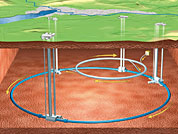Welshman looks for “God particle” in Geneva

After fixing the damage caused by a helium leak, Cern's project leader tells swissinfo that the Big Bang machine should be operational at the end of September.
Lyn Evans, the Welshman behind the Large Hadron Collider (LHC), the world’s largest particle accelerator, talks about last September’s accident on the outskirts of Geneva and the future of the biggest science project in history.
The LHC experiment at Cern, the European Organization for Nuclear Research, involves firing beams of protons in opposite directions around a 27-kilometre tunnel buried 100 metres below the French-Swiss border.
The beams are then smashed together in four bus-sized detector chambers, creating showers of new particles that can be analysed by 7,000 scientists linked to the computer network.
Scientists hope to replicate the conditions one-trillionth of a second after the Big Bang more than 13 billion years ago.
That experiment, which could provide clues about the origins of the universe, began on September 10, 2008, but was shut down nine days later because of major damage blamed on a faulty wiring splice that caused an electrical arc. It is due to restart at the end of September 2009.
swissinfo: How is the “baby”, the LHC?
Lyn Evans: The baby is recovering! We’ve removed a lot of equipment that was damaged and we’re on our way up again.
swissinfo: According to Nature magazine, you’re expecting to be back in business next summer.
L.E.: Yes, at the end of September. One of the main problems is that if anything goes wrong, it takes a lot of time to repair. The machine is at minus 271 degrees Celsius and just to warm it up takes five weeks. And then you need to repair it and wait for another five weeks.
swissinfo: What, in simple terms, are you looking for with the LHC?
L.E.: One of the main issues is what we call “original mass”. Mass translates to weight in a gravitational field. If you are in space you are weightless, but you’ve still got mass.
We already know the fundamental particles of nature. You go from one extreme, which is the photon, the particle of light, which brings the light from the sun and allows us to see and communicate. But it’s got no mass. And at the other end of the scale you find the W and Z particles, which were discovered at Cern in the 1980s and resulted in the Nobel Prize. These particles are also incredibly important: they make the sun shine and burn.
These particles are really heavy; they are 80 times the mass of the protons that we’re made of. And nobody knows what it is that decides that a photon has no mass and the W and Z have so much, and all the differences in between.
So the only possible theory is that there must be another particle, which has been called the “God particle” – an expression that I don’t like. This is the “Higgs Boson”. The Higgs boson would explain the difference between the mass-less photon, which mediates electromagnetism, and the relatively massive W and Z bosons, which mediate the weak force.
If the Higgs boson exists, it would be an integral and pervasive component of the material world. That’s what we’re trying to find.
swissinfo: Is the accident raising the cost of the experiment?
L.E.: The cost of repairing the machine is SFr15 million, which is not much. But the overall cost of the project, including the machine and the detectors, goes up to SFr4 billion.
swissinfo: Could the LHC fail again?
L.E.: Everything is possible, of course. But when you have such an unexpected problem like the one we had, you learn lots from it. We developed tools to make sure that this doesn’t happen again and to avoid new accidents.
The problem we had with the magnets was impossible to detect, but now the machine has been opened, we can see what went wrong. Now we have the necessary technology to handle the beast!
swissinfo: And could the LHC work and not give any results?
L.E.: You can’t really say, as this is scientific research. But I think, quite honestly, that the answer is “no”. But even if the Higgs boson is not there, it would be even more exciting. In that case, there would be something else that we hadn’t thought about.
swissinfo: Even well educated people seem to have serious reservations about the nature of your experiment. How do you answer their criticism?
L.E.: We’re not working on the hydrogen bomb. We’re dealing with tiny amounts of energy, on a mosquito scale (laughs).
If man were afraid of everything new, we would still be in the Stone Age. What happens now has to do with the power provided by the internet, which works as an “amplifier” of uninformed opinion.
Imagine what would have happened at the time of the first experiments with vaccines if the internet had been there. Louis Pasteur wouldn’t have had a chance to work, because his research would have actually been dangerous. Injecting viruses into a human being (laughs).
Across the whole world, not one single credible scientist ever had any problem with what we’re doing here.
swissinfo: Is the LHC “the last big particle accelerator”, as Nature claims?
L.E.: I don’t think any other circular machine such as the LHC will ever be built. There are other proposals for new machines, but society will not build another one until we answer all the questions raised by this experiment.
But if the LHC took 14 years to build, the next machine will take even longer. It’s getting harder and harder to get the last secrets of the universe.
swissinfo-interview: Rodrigo Carrizo Couto in Geneva
The LHC tunnel is 27km long and runs between Lake Geneva and the Jura mountain range.
In the LHC, high-energy protons in two counter-rotating beams will be smashed together to search for exotic particles.
The beams contain billions of protons. Travelling just under the speed of light, they are guided by thousands of superconducting magnets.
The beams usually move through two vacuum pipes, but at four points they collide in the hearts of the main experiments, known by their acronyms: ALICE, ATLAS, CMS, and LHCb.
The detectors could see up to 600 million collision events per second, with the experiments scouring the data for signs of extremely rare events such as the creation of the so-called God particle, the yet-to-be-discovered Higgs boson.
Lyn Evans was born in the Welsh mining village of Aberdare in 1945.
He studied physics at Swansea University and graduated in 1969. He started work at Cern in 1970.
In 1991 he was elected a member of the American Physics Society “for his extraordinary contribution to particle physics”.
In 1994 he was appointed project manager for the LHC.
In 2001 he was awarded the Commander of the Order of the British Empire (CBE) by Queen Elizabeth II.


In compliance with the JTI standards
More: SWI swissinfo.ch certified by the Journalism Trust Initiative














You can find an overview of ongoing debates with our journalists here . Please join us!
If you want to start a conversation about a topic raised in this article or want to report factual errors, email us at english@swissinfo.ch.